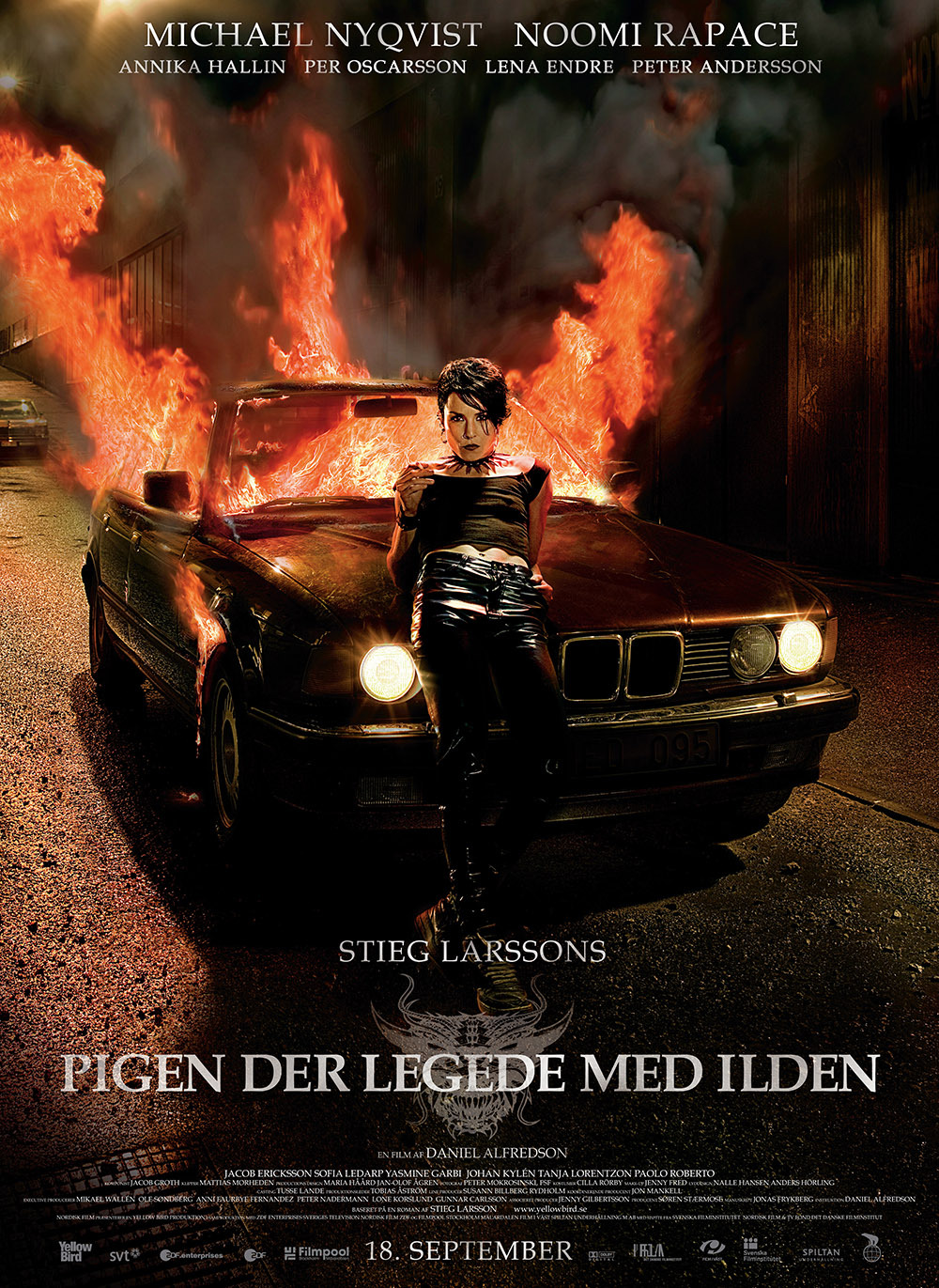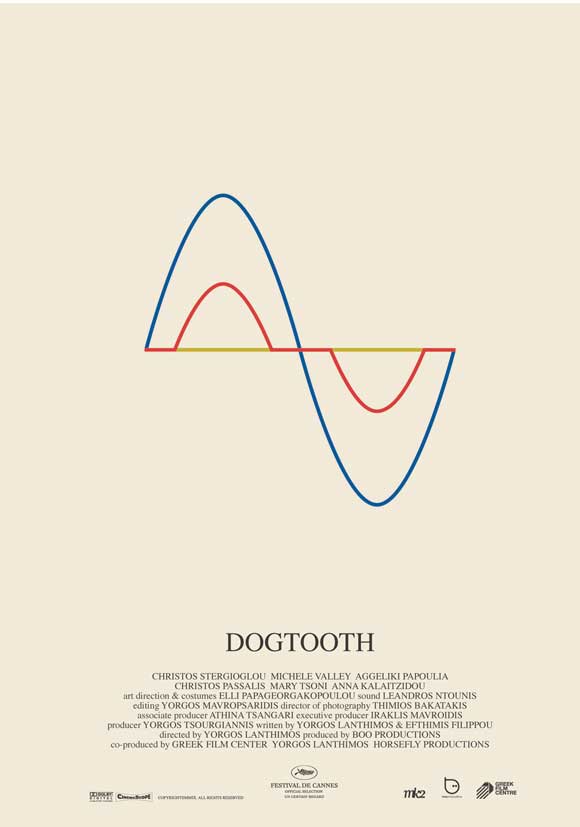 THE GIRL WHO PLAYED WITH FIRE (2010, directed by, 129 minutes, Sweden)
THE GIRL WHO PLAYED WITH FIRE (2010, directed by, 129 minutes, Sweden)
DOGTOOTH (2008, directed by Giorgos Lanthimos, 94 minutes, Greece)
ROBOGEISHA (2009, directed by Noboru Iguchi, 102 minutes, Japan)
DELIVER US FROM EVIL (2009, directed by Ole Bornedal, 100 minutes, Denmark)
BY DAN BUSKIRK FILM CRITIC
She’s back! And this time it’s personal! The girl with the dragon tattoo, the violent bisexual rape revenger Lisbeth Salander returns with the second adaptation from the phenomenally successful best-selling Millennium trilogy. Thankfully shorter than the opening chapter, The Girl Who Played With Fire carries with it most of the same strengths and shortcomings as its predecessor : an intriguing main character and performance, joined with a promising premise that is executed with the ho-hum procedural of a TV detective show. Much like a darker, art house version of the teen vampire Twilight series, Lisbeth is a fantasy wish-fulfillment figure (for men or women? I’m not sure…) whose titillating possibilities are undermined by schlocky, conventional storytelling.
Lisbeth had disappeared into South America as the last chapter ended but returns to Sweden when she discovers her investigative journalist friend Mikael (Michael Nygvist) is uncovering a teenage prostitution ring in his magazine Millennium. As she begins to follow the leads (with her super-human computer hacking skills) when she finds herself accused of a trio of murders, including that of the parole officer/rapist Lisbeth tangled with in the previous chapter.
Perhaps part of the series’ success stems from the fact that there is so much to enjoy and so much about which to complain. On the liking side is Noomi Rapace’s performance as Lisbeth. Intense and nearly mute, the role demands you watch her closely because she’s not going to tell you what to expect. Slight of build and always vulnerable, you gasp at the level of violence she’s willing to engage in to even the odds between her and her hulking pursuers.
Yet the film heaps on the most plodding detective procedural, endlessly following Mikael as he tromps along, following each lead as it leads to another and another and another. Good detective films either wow you with how they whisk you from location to location or they engage you with the eccentric personalities we meet along the way. The Girl Who Played With Fire does neither, too self-serious about its heavy subject matter to give in to its pulpy impulses. If only its study of sexual violence carried more insight; instead its is always held out as a dirty titillation, with Lisbeth’s taciturn manner posing as strength yet functioning as a way to not address the reality of rape and its consequences.
Still, while holding all these reservations I was caught off guard by how powerful the film’s climax was, when Lisbeth confronts her childhood history of domestic violence directly, in a scene the brings here to stare into a black hole of evil that appears cleansed free of morality. It’s almost enough to let you forgive endless trudge we endured to get this point. But only almost. Regardless I’ll be delving back in for the wrap-up when it arrives in October (The Girl Who Kicked The Hornet’s Nest), more out of that damnable, dutiful impulse to see things through to the end than out of sheer pleasure.
– – – – – – – – – – – – – – – – – – –
I spent most of the nineties living in San Francisco, which at the time had a vibrant film-going culture, with six or seven area theaters dedicated to  exploring a wide range of international and home-grown cinema from throughout history. I gorged like a glutton on all kinds of Asian film, Hollywood classics, film noir, gay and lesbian cinema, counter culture oddities and films from numerous nooks and crannies from around the globe. But surprisingly absent in that diet was much in the way of horror films. Maybe it was the politically sensitive make-up of the population but for some reason S.F. was not a horror movie town.
exploring a wide range of international and home-grown cinema from throughout history. I gorged like a glutton on all kinds of Asian film, Hollywood classics, film noir, gay and lesbian cinema, counter culture oddities and films from numerous nooks and crannies from around the globe. But surprisingly absent in that diet was much in the way of horror films. Maybe it was the politically sensitive make-up of the population but for some reason S.F. was not a horror movie town.
But Philly? Philly is a horror movie town. With a tradition that stretches from Dr. Shock to Exhumed Films, there is a strong appreciation of everything ghoulish in the Philadelphia character that explains why even if the Philadelphia Film Festival is heavily bleeding in an uncertain limbo, Danger After Dark, the Festival’s morbidly-obsessed stepchild, will not stay dead. Like Rosie Grier and Ray Milland in The Thing With Two Heads, some mad scientist has sewn Danger After Dark into the Philadelphia Gay and Lesbian Festival, clearing a late night slot for eleven weird offerings over the next eleven days. Curated again by Travis Crawford, Danger After Dark is back for its 10th anniversary, with an unpredictable batch of films for folks who don’t let disturbing subject matter scare them from spending a few hours in the dark with strangers.
Friday night begins the festival with perhaps the most psychologically disturbing of the offerings, Giorgos Lanthimos’ Dogtooth. This story from Greece introduces us to a nameless family, kept in near complete isolation by the man only referred to as “Father.” The wife stays passively by as he keeps his three children (only referred to as “older sister”, “younger sister” and “son”) behind the walls of their isolated estate, where the trio live in a misinformed, child-like state. I was reminded of an 1973 cult film called The Baby, which also plays on how unnerving it is to see adults act out like children. Watching these twenty-somethings as they taunt, explore and occasionally erupt into violence shakes one to the core as we feel the confusion and untethered emotions we left behind in childhood as they begin erupting from these characters. Lanthmos lets much go unexplained as he frames his characters just as carefully as the world their father has created for them. As with many of the Festival’s films, half the fun will be channeling the audience’s discomfort with this nerve-wrecking scenario. Dogtooth will be projected from film.
 Saturday night’s RoboGeisha might be the most flat-out entertaining offering of the festival. The cartoony comic adventure follows two feuding sisters who are deceived and recruited into a secret society who are robotizing young women for a nefarious plot that could destroy Japan’s future. The premise of hyper-violent killer geishas would only carry a film for so long (I was reminded of Mario Bava’s semi-dreadful Dr. Goldfoot and The Girl Bombs) yet RoboGeisha works hard to keep delivering surprises, including euphorically ridiculous bloody battles and surprisingly affecting sisterly discord. Even the cheesey CGI effects have a charm of their own, tapping into the anime/computerized melding that made the godawful Speed Racer feature a guilty visual pleasure. This one has crowd-pleaser written all over it.
Saturday night’s RoboGeisha might be the most flat-out entertaining offering of the festival. The cartoony comic adventure follows two feuding sisters who are deceived and recruited into a secret society who are robotizing young women for a nefarious plot that could destroy Japan’s future. The premise of hyper-violent killer geishas would only carry a film for so long (I was reminded of Mario Bava’s semi-dreadful Dr. Goldfoot and The Girl Bombs) yet RoboGeisha works hard to keep delivering surprises, including euphorically ridiculous bloody battles and surprisingly affecting sisterly discord. Even the cheesey CGI effects have a charm of their own, tapping into the anime/computerized melding that made the godawful Speed Racer feature a guilty visual pleasure. This one has crowd-pleaser written all over it.
Sunday wraps up the weekend’s offerings with a Danish thriller, Deliver Us From Evil. With a seemingly effortless stylishness, Ole Bornedal presents us with a portrait of small town life in rural Denmark that starts out disturbing and builds to a lynch mob ferverish peak. It follows “good brother” Johannes (Lasse Rimmer), settling back uncomfortably with his family in his old hometown among the hicks he looks down upon, and his sadistic ”bad brother” Lars (Jens Andersen in a riveting debut). When Lars accidentally runs over a religious matron of the town with his semi he frames the town’s Bosnian outsider for the crime, all of which coincides with a town festival that finds a motley crew of ragged losers boozing it up recklessly in the beer tent. The performances, direction and writing is spot on, catching you off-guard when the climax coheres into what might be called an unofficial remake of Peckinpaugh’s classic exploration of violence, Straw Dogs. Even though it ends not seeming as original as when it began, the film hardly takes a false step, especially when it comes to coiling up the tension. Deliver Us From Evil will be projected from film.
Special thanks to Philly Weekly’s Matt Prigge for supplying materials or this review
